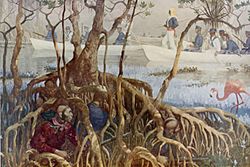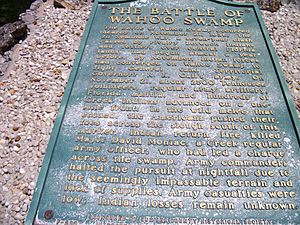Battle of Wahoo Swamp facts for kids
Quick facts for kids Battle of Wahoo Swamp |
|||||||
|---|---|---|---|---|---|---|---|
| Part of Second Seminole War | |||||||
 United States Marines searching for the Indians during the Seminole War. |
|||||||
|
|||||||
| Belligerents | |||||||
| Seminole | |||||||
| Commanders and leaders | |||||||
| Richard K. Call | Osuchee Yaholooche |
||||||
| Strength | |||||||
| 2,500 | approx. 600 | ||||||
| Casualties and losses | |||||||
| Unknown | Unknown | ||||||
The Battle of Wahoo Swamp was a series of fights during the Second Seminole War. It happened in late 1836 in the Wahoo Swamp area of Florida. This swamp was about 50 miles northeast of Fort Brooke (near modern Tampa). It was also 35 miles south of Fort King (near Ocala).
An army led by Florida's governor, General Richard K. Call, fought against Seminole forces. The Seminole chiefs Osuchee and Yaholooche led their people. The battle took place in a large area of wetlands and forests. Today, this area is in Sumter County, Florida.
Contents
Why Did the Battle of Wahoo Swamp Happen?
The Second Seminole War grew much bigger after December 28, 1835. On that day, the Dade Massacre happened. Also, the Seminole leader Osceola killed Wiley Thompson. Thompson was an agent trying to move the Seminoles out of Florida.
The Seminoles and the Black Seminoles faced constant danger. Black Seminoles were Africans who had escaped slavery. They lived in their own villages near the Seminoles. The US Army and local militias wanted to move the Seminoles. They also wanted to return the escaped Africans to those who claimed them as property.
What Was Wahoo Swamp Like?
The Black Seminoles had many small villages. These were along the Withlacoochee River. They grew lots of corn, pumpkins, and sugar cane there. White soldiers knew the Seminoles stored food in hidden areas. These areas were often in forests surrounded by swamps. The "Wahoo Swamp" was one such place.
This large swamp was a strong base for the Seminoles. They hid their families and cattle there. Many Black Seminole families also lived there. So, the white soldiers wanted to destroy these villages. They also wanted to take the supplies. The Seminoles had a lot to lose. They were expected to fight very hard to protect their homes.
On November 14, 1836, General Robert Armstrong marched with 500 horsemen. They were heading towards these settlements. They met a strong group of Seminoles and Black Seminoles. A heavy fight began. Eleven of Armstrong's men were hurt in less than an hour. Still, Armstrong's forces pushed them back. But the Seminoles took their dead and wounded with them. This was important to them. They felt they hadn't lost if they kept their fallen warriors.
The Battle of Wahoo Swamp: Key Events
On November 18, 1836, General Call marched towards Wahoo Swamp. He had 550 soldiers, mostly from Tennessee. About 3 miles from their camp, they found a large Seminole trail. This trail went through thick forests and over two creeks. It led into a big open field. The field was surrounded by forests on three sides.
The Seminoles were moving back to better fighting spots. They set their houses on fire as they left. Finally, they stopped to fight. The Tennesseans formed a line to attack.
First Attack: November 18
The foot soldiers, led by Colonel William Trousdale, got ready to charge. They moved into the forest. The horsemen stayed on the sides to protect the army. They also waited as a backup force. Before they could move forward, a huge burst of gunfire hit them. It came from the forest in front of them.
The soldiers slowly moved forward, firing their guns. Then, they were told to charge. They quickly obeyed. But the Seminoles did not run away as they usually did. They stood and fought hand-to-hand. At the same time, Seminole fighters attacked both sides of the army. A small group of about 50 men attacked from behind.
The battle lasted almost half an hour. Then, a big charge by the soldiers broke the Seminole lines. The Seminoles scattered in all directions. Twenty-five Seminoles were found dead on the field. The white soldiers had three killed and 18 wounded. About 600 Seminoles were said to have fought in this battle. It was getting late, and the soldiers were tired. So, the army went back to meet Colonel Pierce. This meeting spot was near the Dade battleground.
Second Attack: November 21
On November 21, General Armstrong ordered another attack. The army marched into the swamp in three groups. The Tennesseans and regular soldiers were on the right. Colonel Pierce led the center group. The Creek soldiers were on the left. Their line stretched for a full mile. When they reached the battleground from November 18, the Seminoles were there again.
As the Tennesseans and regulars moved forward, heavy gunfire hit them. But they waited to fire back until they were very close to the Seminoles. Then, they charged. The Seminoles gave way and retreated.
A group of soldiers was waiting as backup. They saw where the Seminoles were retreating. Colonel Pierce and the Creek soldiers were ordered to chase them. Soon after, Colonel Trousdale and Colonel Warren's horsemen were sent to help. Most of the regular soldiers and Tennesseans took a path to the right. They got stuck in a very difficult swamp. Horses could not move there. The men had to walk waist-deep in mud and water.
A small group of Creek warriors, led by Colonel Brown, took a better path. They followed the enemy closely. They found the Seminoles strongly set up in a cypress swamp. The Creeks charged them. Their leader, Major David Moniac, was killed. He was a Creek warrior who was the first Native American to graduate from West Point. Several other Creek warriors also died.
It soon became clear that this group might be defeated. The fight was getting very hard. Then, more soldiers arrived. Two companies of Florida militia joined. Three companies of artillery also came. Colonel Waire and his horsemen arrived too. These new forces helped the Creeks hold their ground.
The Seminoles were not forced out until almost all the Tennessean forces arrived. This was the end of the second battle at Wahoo Swamp. General Call's army had 25 casualties, with nine killed. The Seminoles left 10 dead on the field. But the white soldiers believed the Seminoles lost "at least 50."
General Call had pushed the Seminoles back through the swamp. The Seminoles retreated south by nightfall. Call chose not to chase them because the land was too hard to cross. The army had used up all its food. They made their way out of this tough area. They returned to their camp at 10 o'clock that night. The next day, they marched to Volusia.
What Happened After the Battle?
The plan to defeat the Seminoles started in the fall of 1836. General Call led this effort. He was a friend of President Jackson. He had also fought in earlier Indian Wars. However, his plan did not succeed. He failed to stop the Seminole resistance.
Call led a large force of volunteers, regular soldiers, and Creek fighters. He did manage to push the Seminoles from their strongholds. These were near the Withlacoochee River. But he was stopped at the Battle of Wahoo Swamp. He could not move forward in the swamp. So, he fell back to Volusia. This gave the Seminoles time to escape. They went into the wild, unexplored parts of Florida. From there, they kept sending small groups to attack white settlements.
On December 9, General Call was replaced. Major General Thomas Jesup took over command. Jesup returned with the federal troops to Fort Brooke. The volunteer soldiers' time of service ended in late December. So, they went home.
Osceola himself led quick attacks against Army groups and outposts. He continued these raids until October 21, 1837. He was captured under a white flag of truce. This happened near Fort Peyton, south of St. Augustine. General Joseph Marion Hernández captured him, following General Jesup's orders.


